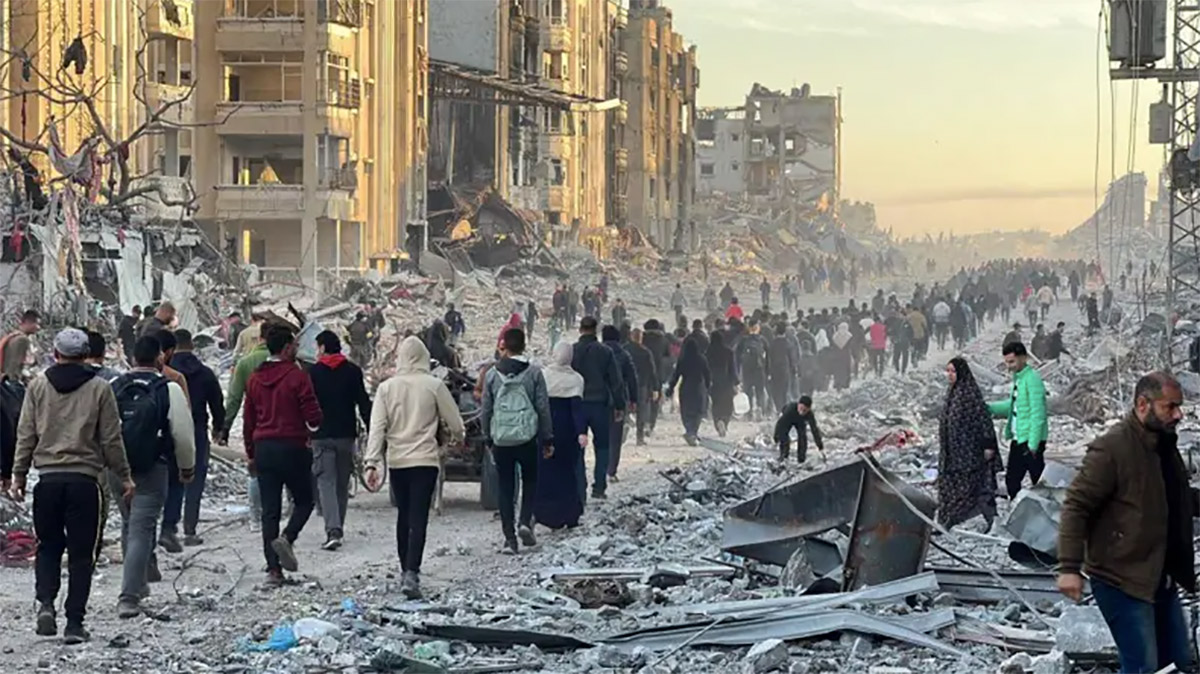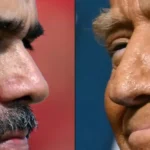
Since noon on October 10, when the ceasefire in Gaza formally began to take effect, a wave of humans, on foot, in dilapidated trucks, in cars or bicycles, once again began the march back to Gaza City, or rather, what remains of it after the brutal offensive and land occupation of the Israeli army. The sense of collective relief of the Palestinian people, expressed in the celebrations in the streets, coexists with the desolation at the immeasurable destruction of the genocide perpetrated by the state of Israel that has been going on for two years: ruins and rubble where there were schools, hospitals and homes. Almost 70,000 Palestinians dead, including 20,000 children, although the final count may more than double that figure (a retired Israeli general admitted that the dead and wounded amount to almost 10% of Gaza’s population). Carefully managed famines. Scorched earth. In short, the indelible mark of a genocidal plan to achieve the Netanyahu government’s explicit objective of carrying out a new ethnic cleansing and annexing the Palestinian territories to “Greater Israel.” Not coincidentally, one of the most read and heard phrases these days is the definition of the historian Tacitus at the height of the Pax Romana: Where they make a desert, they call it peace.
The “20-point plan” announced by Trump to supposedly end the conflict in Gaza is the result of a laborious negotiation between Donald Trump’s personal envoys (his friend S. Witkoff and his son-in-law J. Kushner), the Israeli government and the Arab and Muslim regimes allied to the United States, who assumed the dual role of pressuring Hamas to achieve the greatest concessions of the resistance. Palestinian territory and, at the same time, limit Netanyahu’s expansionist aspirations that led to the mass expulsion of the Palestinian population. But what began as an ultimatum towards Hamas – demanding its disarmament in 72 hours (!) and its virtual disappearance by ceding Gaza to a consortium chaired by Trump himself and Tony Blair – ended up opening a negotiation process more in line with the reality on the ground.
The first stage, signed by Israel and Hamas in Sharm el Sheikh with the mediation of Egypt and Qatar, contemplates four points: the ceasefire that is already being implemented – although Israel murdered at least 60 Palestinians in the first hours of the truce and its snipers will probably continue murdering Gazan civilians. The partial withdrawal of the Israeli army behind the negotiated lines means that it would go from occupying 80% of the Gaza Strip to 53% of the territory. The exchange of all Israeli hostages held by Hamas – 20 alive and 28 dead – for the release of approximately 2,000 Palestinian prisoners, including 250 senior members of Palestinian resistance organizations sentenced to life imprisonment in Israel. And the unrestricted entry of humanitarian aid managed by the United Nations (there is talk of 400 to 600 trucks a day) that the Zionist state had withheld, replacing it with its own agency managed by mercenaries, as part of the sinister policy of using hunger as a weapon of war.
In the framework of a tense negotiation – with last-minute tug-of-war over the list of Palestinian prisoners that Israel would release – there is a feeling of already seen which refers to the last agreement negotiated in January 2025 and broken two months later by Israel in March, when Netanyahu decided to resume the genocide in Gaza and thus avoid the fall of his government due to the abandonment of the coalition of his far-right partners.
The antecedent undoubtedly enables the hypothesis of failure. However, it seems that this time it will be more difficult for Netanyahu to return to genocide as usualdue to a combination of factors of a different nature, which involve everything from the geopolitical dimension to the class struggle.
In this sense, there are at least three gravitating elements for the timing and the eventual future of the agreement.
Firstly, the impact on regional balances from Israel’s attack against Hamas negotiators in Qatar, an indispensable ally for the United States, which not only plays a diplomatic role at the service of North American interests but is also home to the main imperialist military base. This scandalous violation of Qatari sovereignty put the rest of the United States’ Arab allies in the region on alert. And as several journalists report, it infuriated Donald Trump who considered that Israel, which is his priority ally but also his client, had gone too far and put at risk his plan for “normalization” of the Middle East – an expanded version of the Abraham Accords, which would allow juicy businesses to flourish with the Gulf monarchies. Which led to a humiliation for Netanyahu, who from the Oval Office and under the watchful eye of Trump had to apologize to the Qatari prime minister.
Secondly, Trump’s personal involvement is the main support – financial, military and diplomatic – of the Zionist state, so any violation of the terms of the agreement translates into a direct challenge to Netanyahu’s boss. This in the context of the fact that the unconditional alliance of the United States with Israel is being questioned internally. According to a recent New York Times/Siena poll, for the first time a slight majority of the American population sympathizes with the Palestinians and not with Israel. As Trump himself recognized, this drop in Israel’s popularity reached the militant heart of the Republican base referenced in the MAGA movement and its main spokespersons such as S. Bannon (and privately Charles Kirk elevated to the category of martyr of the extreme right), who question everything from Israel’s influence in North American foreign policy (Israel First instead of America First, they say with sarcasm) to money. of taxpayers – $21 billion from October 2023 – destined to finance the genocide of the Zionist state.
Last but not least, the profound delegitimization of Israel by genocide, expressed in the last United Nations vote, leaves the United States practically alone, taking charge of the defense of the Zionist state and its aberrant crimes, accompanied by a handful of sepoys like Milei. In this qualitative international isolation of the Zionist state, the powerful movement against the genocide and in solidarity with the Palestinian people plays a central role, which has become a major political problem for the European governments allied and accomplices of Israel, some of which chose to recognize the Palestinian state to alleviate internal pressure, as in the case of Great Britain.
It is to be hoped then that if “everything goes according to plan” – as the messianic extreme right would say – by October 15 the hostages would be back in Israel. Although it can always fail, the most certain indication that this is feasible is the sending of around 200 American soldiers to the area and that Donald Trump plans to travel that same day to Tel Aviv to capitalize on what he considers the main diplomatic achievement of his presidency, with which he could compensate for the so far failed negotiation with Putin and Zelensky to end the war in Ukraine. Trump’s aspiration, beyond his personal vanity (winning the Nobel Peace Prize, which did not happen this year) which undoubtedly plays an important role, is to take steps to rebuild the declining leadership of the United States, demonstrating that it is the only power that can establish order and discipline allies and enemies, thinking strategically about the dispute with China.
But beyond the immediate situation of ceasefire, opened by this first stage, everything is uncertainty.
Without a doubt, on paper, the 20-point plan proposed by Donald Trump is an ambitious colonial project, whose ultimate objective is to impose a protectorate in Gaza, under the tutelage of imperialism and its Arab allies, establish Israel’s colonial rule over the West Bank, legalizing the apartheid already imposed by the expansion of illegal settlements, although without formal annexation of the entire territory or the expulsion of the population. Palestine, which is the plan of the settlers and the strongest parties in Netanyahu’s coalition. But in fact, it is fundamentally a ceasefire agreement, a tactical pause, rather than a “final solution” based on the only thing that could sustain it: Israel’s “total victory” over Hamas – and more generally, the historic defeat of the Palestinian struggle – that Netanyahu has unsuccessfully pursued since the beginning of the genocide in Gaza after the Hamas attacks of October 7, 2023. This despite the devastation of Gaza and the military successes of the Zionist state – notably the beheading of the leadership of Hamas and Hezbollah – and the parallel offensive in the West Bank.
Assuming that the ceasefire is sustained and that the first stage passes without major incidents, the following phases of the agreement pose practically insurmountable difficulties. Hamas will not accept to simply disarm and disappear (why would it if it managed to survive in two years?) and has already advanced in its declaration of partial acceptance of the Trump plan that it would agree to a future Arab government in Gaza, within the “Palestinian political structure” that includes them. Netanyahu would once again be faced with the dilemma posed to him by the previous agreement: two years of genocide to return to a similar situation on October 6, 2023. Although the agreement does not explicitly mention an (unlikely) Palestinian state, it rejects the annexation of the Palestinian territories and the displacement of the population, which is the central program of Netanyahu’s main partners, B. Smotrich and B. Gvir, and therefore which in March put Bibi’s government on the brink of collapse. In this context, there are several possible scenarios: the government could fall and call for early elections. Israel could resume large-scale attacks on Gaza or it could return to its colonial routine of “incremental genocide.”
Without a doubt, the geopolitical interests of North American imperialism in the Middle East enter into the equation, colliding with Netanyahu’s permanent war policy that he has extended to the allies of the United States. But in addition to the geopolitical dimension there is the class struggle. In the immediate future, the convergence between the Palestinian resistance and the international solidarity movement – which has taken a leap, as seen in the general strike in Italy (See: “Italia moves” by Juan Dal Maso in this issue of Left Ideas) and the enormous impact of the Sumud Global Flotilla – has put a limit on genocide. The deepening and radicalization of this struggle is what will be able to definitively defeat the genocidal state of Israel and its imperialist accomplices.
Source: www.laizquierdadiario.com

